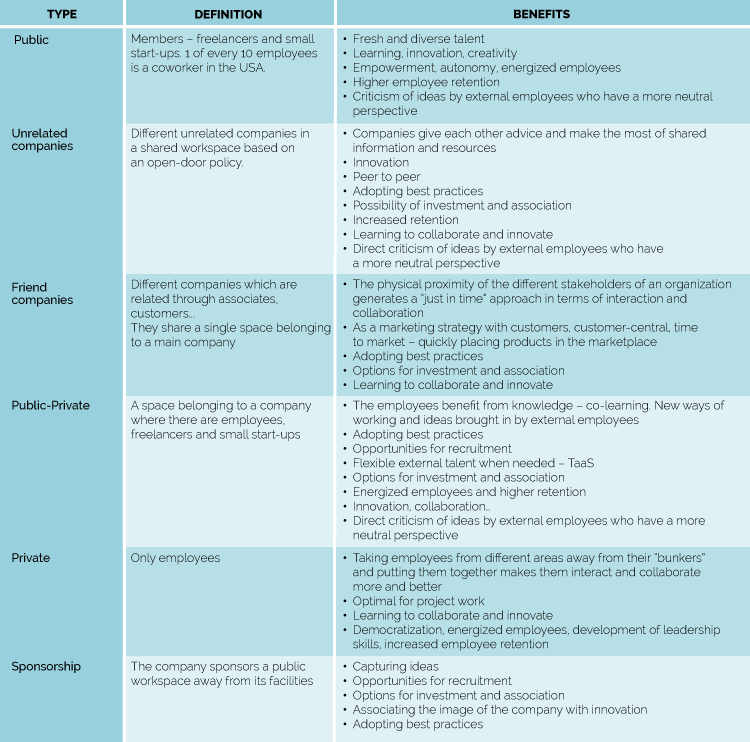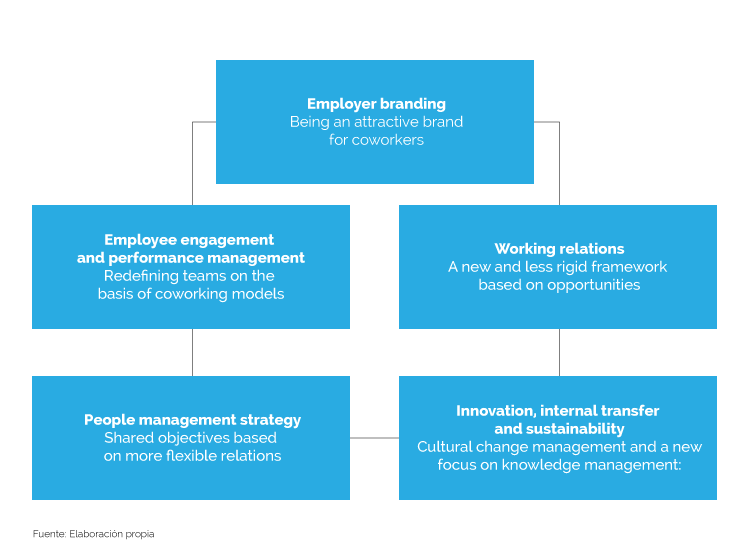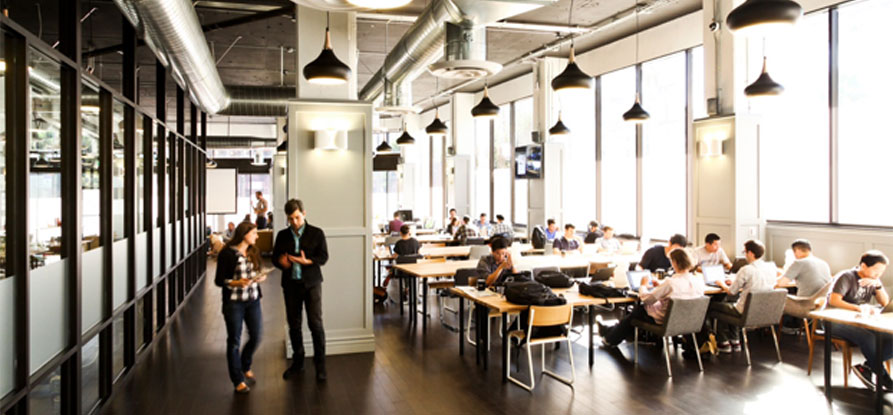Published in Observatorio de RH (The HR Observatory) – July 2016
Origins of coworking and its rapid evolution
Founded in Berlin in 1995, C-base was one of the world’s first hacklabs: a community-operated workspace for people actively interested in science, new technologies and the digital world, providing a scenario for them to meet and work on different projects. Such hacklabs are the predecessors of the coworking spaces as we know them today.
And in 2013 over 100,000 people were already actively involved in such coworking spaces.
Coworking is a trend that continues to grow and is becoming increasingly popular, not only among small work groups, but also with large corporations who wish to make the most of the potential of collaborative work within their organizations. This is known as “corporate coworking”
Factors that have led to an increase in corporate coworking
We have seen an increase in this approach to working particularly in terms of the Y generation or Millennials (born between 1980-2000) and they will be the dominant workforce in the economy for a long time to come. The Millennials are promoting technology, communities and new sharing economy-based companies, and those organizations aiming to attract brilliant and creative professionals will have to do the same in order to connect with them in new creative ways.
In the United States, 35% of economy-based workers are currently independent and it is estimated that this percentage will rise to 40% by 2020. As professionals can no longer rely on their college degrees to translate into jobs, workers have become more flexible and creative in their professions: they are starting up companies and creating their own jobs. The current state of the economy has significantly influenced the advent of the new workforce, and where and how we work.
Furthermore, many knowledge professionals are voluntarily choosing to work outside corporations. Although they are currently symbolic in number, they do however constitute a potential exodus of the best talent towards new and much more flexible professional careers.
Finally, companies recovering from the economic crisis, are shifting from fixed structures to flexibility at work, cloud-solutions and super efficiency scenarios – often losing, in the process, their capacity to innovate in order to maintain their relevance.
This is the mantra that leads us to combine coworking with companies in order to help them evolve with the demands and expectations of the new workforce.
Types of corporate coworking
The first type is “traditional coworking “, i.e. coworking spaces which operate on the basis of a membership model, made up of independent professionals and a number of teleworkers involved in their own projects in one single physical scenario. This is the business-incubator model to which large corporations are not invited.
The second type is the so-called “non-competing company model” with two or more companies sharing premises in which they work together. The model is based on unrelated corporation sharing and involves the companies sharing a workspace that none of them owns (GRid70 in Michigan is a good example of this).
The third type is the “friends of the corporation model”, in which the companies know each other and interact (developers, strategic partners and even customers) and are invited by the main company to share its corporate space (three AT&T innovation centers are excellent examples of this model).
The fourth type is the “startup only model” (also referred to as “public-private”) in which related or unrelated startups are invited to share corporate office space. This model involves companies having open spaces to which they invite non-employees, and also functions as a coworking scenario for their own employees. The Downtown Zappos project in Las Vegas is a very good example of this public-private model, and is perhaps the most ambitious of its type worldwide. AT&T are also experimenting with this model.
The fifth model is the “private model” and involves corporations that decide to create a coworking space at their headquarters. It involves private spaces open exclusively to employees. In the case of Coca-Cola, for example, employees were particularly slow to adopt this concept. This was due, in part, to the fact that the employees originally had fixed offices and, in part, because Coke was still run with very tight departments. A few months after their experiment, they had to act accordingly in order to attract their employees to the workspace. The Coca-Cola model shows that, even in the case of companies who are prepared to experiment with new approaches, cultural change is necessary for all the potential of corporate coworking to become a reality.
The sixth type is the “sponsorship model”, in which a company sponsors a coworking facility. An excellent example of this model is Google’s impressive “campus” coworking building in East London (and soon to be applied in Madrid), in which Google employees, who do not physically work at the sponsored facility, visit the building when events are held there to come up with ideas and act as their coworkers’ mentors.
Here is a figure featuring all the different types of corporate coworking we have described and the benefits they can offer to organizations that decide to put them into practice:

Key elements of people management for a successful implementation of coworking
Making the most of coworking and its different models poses obvious challenges in the field of people management.
Some examples: how do we share strategies and inspire engagement in people who do not form part of your team, or even your organization? How can we measure the effectiveness of coworking both quantitatively and qualitatively (with measures that are sometimes necessarily unconventional)? How do we avoid the potential risk of illegal contracts when placing employees at the disposal of another company, or in terms of physical safety or information in corporate environments that are much more flexible or employ external personnel?
Here is a model showing some of the key aspects to reflect upon prior to implementing internal or external co-working.

Here is a more in-depth description of the elements of this model in a public-private coworking scenario: an owned space in which freelancers and/or start-ups work together.
– People management strategy:
Defining the vision, values and flexible processes that are inclusive for employees and external personnel and, at the same time, segmenting policies according to the collective will be fundamental in clarifying the rules of the game and generating motivation and direction in the long term.
-Work commitment and performance management:
Rethink the key elements of employee engagement to integrate this new approach to working by focusing on various rational elements (e.g. compensation, work responsibilities), emotional aspects (recognition, alignment with the culture and the team) and transcendental factors (combination of personal values with the company’s mission). It is very important to have good engagement in the entire perimeter (both employees and external staff) so that this new approach will be sustainable and give good results in both the short and long term.
– Employer branding.
Design a proposal with differential values and a “soul of its own” which will reflect the essence of the company’s brand and contain profile-adapted features. In addition to good total compensation, elements should be included such as continuous development, work flexibility, innovation/co-creation, work-life balance and diversity.
– Labor relations.
To avoid risks that may endanger coworking, we should establish processes and contracts to ensure compliance with the legislation relating to commercial, work and occupational risk-prevention factors. This will help prevent the risk of unlawful contracting in the event of conflict, establishing the role of each actor in the ecosystem and solid criteria in terms of knowledge management and security.
– Change management and innovation.
Identifying the levers for its initial implementation and sustainability will be a key to success. To this end, it would be important to analyze aspects such as the benefits of co-working for the company and the different communities (in both a business and personal context), cultural change, sponsors at different levels of the company, existing barriers and proposals to overcome them, key phases and quick successful consolidation, etc.
An important element is the definition of management ratios (particularly for management and key sponsorship at different organizational levels and both initial and consolidated sales).
Examples of ratios that could be used: improved internal and external reputation (lower voluntary rotation, number and quality of external candidates), improved internal commitment, more innovation (number and quality of the ideas generated by coworking), accelerated learning and improved leadership (as measured in surveys dealing with engagement, 360º feedback and development centres).
Successful cases
There are already many initiatives that apply coworking in corporate spaces.
Here are some of the most interesting:
AT&T
In the past few years, the population of coworking spaces has reached beyond freelancers. Chris Mach, a global work strategist at AT&T has placed dozens of his top researchers, product developers and technologists in coworking centres across the country and has invited new companies and partners, such as Ericsson, to work alongside them. The goals: talent, inspiring creativity and being quicker to place products in the marketplace. AT&T was one of the first companies to place employees in such workspaces.
Zappos
Tony Hsieh, CEO at Zappos has been the staunchest defender of the corporate version of coworking. His goal, he says, is to make Las Vegas “the capital of the world of coworking and co-learning”, with his 3C-objectives: Collision, Community and Co-learning. He is now expanding the concept to generate casual meetings in the surrounding areas.
The new Zappos campus is a large extension of coworking ideals. What does this actually mean? Zappos is trying to build an entire community, a mini-city by encouraging many people to live, play and work in the area where their offices are located. The surrounding community is the campus itself. This is an idea that could be explored by more companies.
Architect Jennifer Magnolfi had the idea of inviting 2 million residents in the city’s metropolitan area to work from Zappos’ new headquarters. It is almost certainly the most striking example of public-private coworking worldwide. It is also the dream of Zappos’ CEO, Tony Hsieh: the Downtown project, 350 million dollars to catalyse both the city and companies, consciously aiming to erase the dividing line between the two.
Hsieh’s thoughts about corporate evolution are borrowed from Harvard University economist Edward Glaeser, who has described cities as the biggest serendipity machines of all times. For Glaeser, the larger the cities, the more they encourage those casual encounters that unleash innovation and productivity. In the case of companies, however, the bigger they get, the more sclerotic they become. At Zappos, to avoid a similar fate, Hsieh thought he needed to take the company to a city, and subsequently moved 200 of its 1,400 employees from a suburban campus into the centre of Las Vegas, to which the remaining workers were transferred the following year. As part of Hsieh’s plan was to turn Las Vegas into “the world’s coworking capital”, Magnolfi proposed the creation of a coworking space on the ground floor of the building, essentially a membrane through which non-employees and employees would pass and collide. Hsieh wants to project the company outwards, transforming all the bars and restaurants in the centre into an extension of their conference rooms and thus attracting hundreds of new companies, students and small businesses into Zappos’ orbit.
Google
In Madrid, as in London, Google is supporting a campus- the Google Campus, with the aim of discovering interesting people. “For companies that seek to acquire a lot of talent, something like this makes a lot of sense,” says Elizabeth Varley, CEO of TechHub, the global tech startup community in London.
Endesa
Another good example was conceptually designed by Monday Happy Monday, whose CEO, Maite Moreno, is co-author of the present article. In the new Endesa Open Power Space employees and external collaborators can share their ideas and work together and its aim is to become a meeting point for talent and a core of collaborative work specially designed to promote cooperation and shared creative processes. It shows us that corporate coworking is not only product for technological organizations, but also for any company that chooses to “be digital”, as they both (concept and digitalization) have shared values.
It is a site designed to boost collaboration between company employees, external collaborators and partners; a space to generate ideas that, in the not too distant future, may lead to the creation of new, more efficient and sustainable models of energy.
Endesa’s digital plan aims to create applications and systems of collaboration, through a different approach, with fast and flexible projects giving rise to rapid changes to meet customers’ needs. And this collaborative work environment is indeed the core from which they intend to generate such projects with the cooperation of the most innovative minds.
The energy sector is undergoing a profound transformation, customers are changing rapidly and there is a need to smoothly adapt to such changes. This means that Endesa has to change its approach. The Open Power Space (OPS) is the seed of change Endesa needs in order to meet its strategic objectives. This will also serve to help the company create future products and services that will respond to new business demands.
Endesa’s Open Power Space aims to serve as a catalyst to transform the company, through innovative projects and with special emphasis on the digitalization of its activities. With an open design, with no offices or assigned spaces, the OPS seeks to promote collaboration, creativity and the use of new work methodologies, in addition to attracting digital talent.
All the employees who are working on collaborative projects, innovation, digital transformation or new ideas can participate in the OPS and thus help to boost the digital transformation that is taking place within Endesa. It is a strategic concept based mainly on opening up to the outside world. At present, in a world moving at high speed, diverging and in constant search for new solutions, Open Power is a way of opening up to new technologies, reaching out to everyone and offering increasingly advanced services to find solutions for the major challenges we are facing.
The role of the OPS’s host mainly involves managing the space and making it dynamic in order to generate knowledge-sharing between teams and inviting different projects from the field we have described to participate.
Conclusiones
Coworking is a new form of working that fits in well with the current model of innovation economy and an open society. In addition to being a new approach to working, it is a form of change management for any organization that wishes to promote its implicit values (diversity, external openness, creativity, shifting from comfort zones…)
If managed wisely and adapted to each organizational culture and business challenges, it can become a significant competitive advantage, both to generate new ideas that will increase profitability and enhance the engagement and development of internal teams. Are you valiant enough to give it a go?
Maite Moreno (Directora de Monday Happy Monday) / David Reyero (Senior HR Business Partner – Sanofi Iberia)

Leave a Reply